
Pottery, due to its relative durability, comprises a large part of the archaeological record of ancient Greece, and since there is so much of it, it has exerted a disproportionately large influence on our understanding of Greek society. The shards of pots discarded or buried in the 1st millennium BC are still the best guide available to understand the customary life and mind of the ancient Greeks. There were several vessels produced locally for everyday and kitchen use, yet finer pottery from regions such as Attica was imported by other civilizations throughout the Mediterranean, such as the Etruscans in Italy. There were a multitude of specific regional varieties, such as the South Italian ancient Greek pottery.
Kleitias was an ancient Athenian vase painter of the black-figure style who flourished c. 570–560 BCE. Kleitias' most celebrated work today is the François Vase, which bears over two hundred figures in its six friezes. Painted inscriptions on four pots and one ceramic stand name Kleitias as their painter and Ergotimos as their potter, showing the craftsmen's close collaboration. A variety of other fragments have been attributed to him on a stylistic basis.
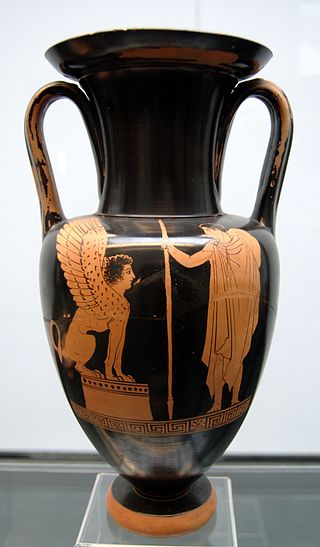
The Achilles Painter was a vase-painter active ca. 470–425 BC. His name vase is an amphora, Vatican 16571, in the Vatican museums depicting Achilles and dated 450–445 BC. An armed and armored Achilles gazes pensively to the right with one hand on his hip. The other hand holds a spear. On the opposite surface a woman performs libation.
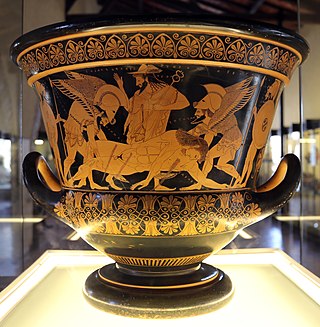
The Euphronios Krater is an ancient Greek terra cotta calyx-krater, a bowl used for mixing wine with water. Created around the year 515 BC, it is the only complete example of the surviving 27 vases painted by the renowned Euphronios and is considered one of the finest Ancient Greek vases in existence.

Nikosthenes was a potter of Greek black- and red-figure pottery in the time window 550–510 BC. He signed as the potter on over 120 black-figure vases, but only nine red-figure. Most of his vases were painted by someone else, called Painter N. Beazley considers the painting "slovenly and dissolute;" that is, not of high quality. In addition, he is thought to have worked with the painters Anakles, Oltos, Lydos and Epiktetos. Six's technique is believed to have been invented in Nikosthenes' workshop, possibly by Nikosthenes himself, around 530 BC. He is considered transitional between black-figure and red-figure pottery.

Andokides was an ancient Athenian vase painter, active from approximately 530 to 515 BC. His work is unsigned and his true name unknown. He was identified as a unique artistic personality through stylistic traits found in common among several paintings. This corpus was then attributed by John D. Beazley to the Andokides Painter, a name derived from the potter Andokides, whose signature appears on several of the vases bearing the painter's work. He is often credited with being the originator of the red-figure vase painting technique. To be sure, he is certainly one of the earliest painters to work in the style. In total, fourteen amphorae and two cups are attributed to his hand. Six of the amphorae are "bilingual", meaning they display both red-figure and black-figure scenes.
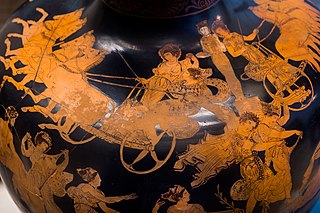
The Meidias Painter was an Athenian red-figure vase painter in Ancient Greece, active in the last quarter of the 5th century BCE. He is named after the potter whose signature is found on a large hydria of the Meidias Painter’s decoration, excavated from an Etruscan tomb. Eduard Gerhard first identified this inscription in 1839, and it was he who determined the scene on the vase was the rape of the daughters of Leukippos where previously it was thought to be the race of Hippomenes and Atalanta.
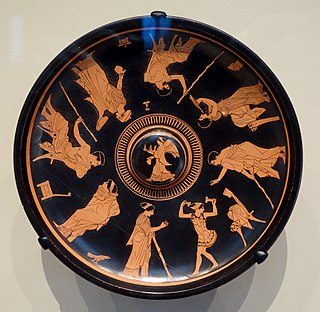
The Phiale Painter, also known as Boston Phiale Painter, was a painter of the Attic red-figure style. He was active around 460 to 430 BC. The Phiale Painter is assumed to have been a pupil of the Achilles Painter. In contrast to his master, he liked to depict narrative scenes. He painted several large calyx kraters, often with two registers of figures; unlike his master, he seems to have preferred larger vessels in general. This is shown by his white-ground works, which are not well known, but more expressive than those of the Achilles Painter. Apart from a number of lekythoi, he painted two chalice kraters in white-ground technique, a rarity at the time. His themes may be partially influenced by contemporary theatre. His preferred name for kalos inscriptions is that of Euaion, son of Aeschylus.

The Pan Painter was an ancient Greek vase-painter of the Attic red-figure style, probably active c. 480 to 450 BC. John Beazley attributed over 150 vases to his hand in 1912:
Cunning composition; rapid motion; quick deft draughtsmanship; strong and peculiar stylisation; a deliberate archaism, retaining old forms, but refining, refreshing, and galvanizing them; nothing noble or majestic, but grace, humour, vivacity, originality, and dramatic force: these are the qualities which mark the Boston krater, and which characterize the anonymous artist who, for the sake of convenience, may be called the 'master of the Boston Pan-vase', or, more briefly, 'the Pan-master'.
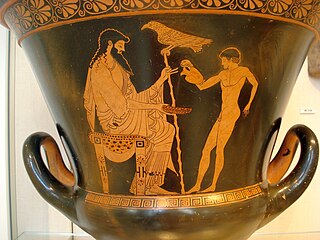
Eucharides Painter is the common nickname of an ancient Greek artist who decorated but did not sign Attic vases. Neither his real name, nor the dates of his birth and death are known. Presumably this artist was a pupil of the Nikoxenos Painter.

Siren painter is the name given to an ancient Greek artist who decorated but did not sign Attic red-figured vases. His real name is unknown, as are the date of his birth and death.

The Athena Painter was an Attic black-figure vase painter, active about 490 to 460 BC. His speciality were white-ground lekythoi painted in the black-figure style.
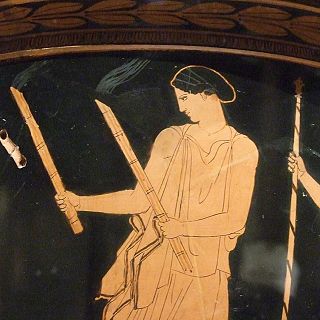
The Persephone Painter, working from about 475 to 425 BCE, is the pseudonym of an ancient Attic Greek vase painter, named by Sir John Beazley after investigating a red-figure bell-krater vase of about 440 BC, which includes a mythological scene of the return of Persephone from Hades. This name vase of the Persephone Painter currently resides at the Metropolitan Museum of Art in New York City.

The Little masters were a group of potters and vase painters who produced vases of the Attic black-figure style featuring well-done figures in miniature. They were active in Athens approximately 560–530 BC. They mainly produced Little-master cups: lip cups, band cups, and droop cups, but were not entirely limited to such shapes. The group includes:

The Phrynos Painter was an Attic black-figure vase painter, active in Athens between c. 560 and 545 BC. He was allocated the conventional name "Phrynos Painter" after the potter Phrynos, as he had painted three cups signed by the latter:

The Lysippides Painter was an Attic vase painter in the black-figure style. He was active around 530 to 510 BC. His conventional name comes from a kalos inscription on a vase in the British Museum attributed to him; his real name is not known.

The Chrysis Painter was an anonymous ancient Greek red-figure vase painter who worked in Athens around 420–410 BC. He is identified by his name vase, a hydria now kept in the Metropolitan Museum of Art in New York . which has the name "Chrysis" (ΧΡΥΣΙΣ) inscribed next to the figure of a woman. He has been described as belonging to the school of the Dinos Painter.
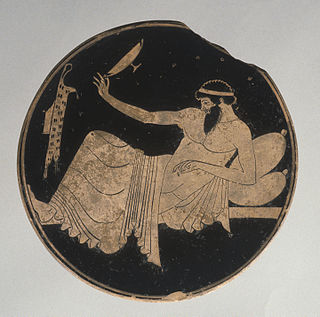
The Bryn Mawr Painter is the name given to an Attic Greek red-figure vase painter, active in the late Archaic period.

The Amykos Painter was the name given to a South Italian vase painter who worked in the ancient Greek red-figure pottery technique. His exact date of birth and death are unknown.

The Chicago Painter was an ancient Greek vase painter, active in Athens, Greece, in the middle of the 5th century BCE. His real name is unknown, but like many other ancient Greek vase painters, his style was recognized in several works by the British classical archaeologist and international authority of Attic Greek vases, Sir John Beazley (1885–1970). Beazley was exceptionally talented at identifying the individual signature styles of different Greek painters, which could be recognized in something as subtle as the composition of eyes, noses, or hands.





















